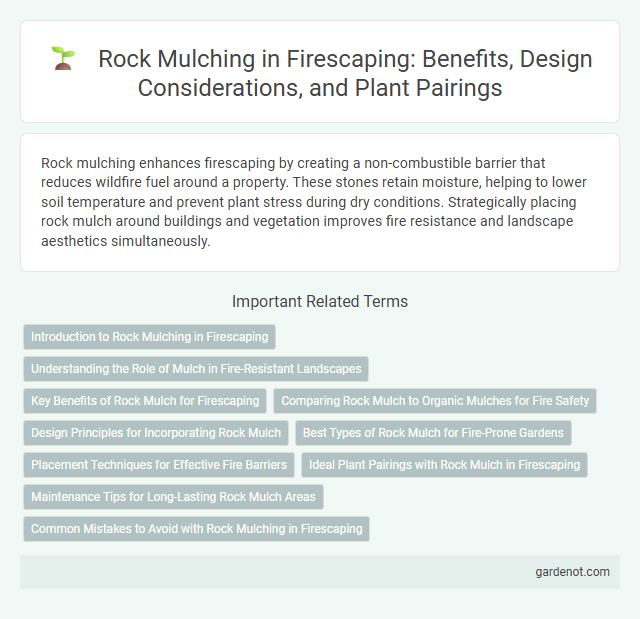Rock mulching enhances firescaping by creating a non-combustible barrier that reduces wildfire fuel around a property. These stones retain moisture, helping to lower soil temperature and prevent plant stress during dry conditions. Strategically placing rock mulch around buildings and vegetation improves fire resistance and landscape aesthetics simultaneously.
Introduction to Rock Mulching in Firescaping
Rock mulching in firescaping involves strategically placing rocks around plants and structures to reduce wildfire risks by minimizing combustible mulch material. This technique enhances soil moisture retention and erosion control while serving as a fire-resistant barrier that slows or stops fire spread. Incorporating rock mulch in defensible space improves property protection by reducing fuel continuity and heat intensity during wildfires.
Understanding the Role of Mulch in Fire-Resistant Landscapes
Rock mulching plays a crucial role in firescaping by creating a non-combustible barrier that reduces the spread of flames and minimizes heat transfer to plants. Incorporating inorganic mulches like gravel or river rock around structures and vegetation helps retain soil moisture and prevents the accumulation of dry, flammable organic material. Strategic placement of rock mulch enhances landscape fire resistance by interrupting fuel continuity and protecting critical root zones from intense heat exposure.
Key Benefits of Rock Mulch for Firescaping
Rock mulch provides effective fire resistance by creating a non-combustible barrier around plants and soil, reducing the risk of ignition during wildfires. Its durability prevents erosion and retains soil moisture, promoting healthier plant growth while minimizing maintenance needs. The thermal properties of rock mulch help to moderate soil temperature fluctuations, aiding in the resilience of fire-adapted landscaping.
Comparing Rock Mulch to Organic Mulches for Fire Safety
Rock mulching offers superior fire resistance compared to organic mulches, as it does not ignite or produce flammable debris. Organic mulches, such as wood chips and bark, can increase wildfire risk by easily catching fire and fueling flames. Choosing rock mulch in fire-prone areas creates a safer landscape by reducing combustible materials near structures.
Design Principles for Incorporating Rock Mulch
Rock mulching in firescaping leverages principles such as strategic placement around plant bases to reduce wildfire fuel and enhance moisture retention. Selecting appropriately sized and heat-resistant rocks ensures durability while minimizing potential fire hazards. Integrating rock mulch with native, fire-resistant vegetation maximizes landscape resilience and supports ecological balance.
Best Types of Rock Mulch for Fire-Prone Gardens
Granite and basalt rocks are among the best types of rock mulch for fire-prone gardens due to their heat resistance and ability to reduce ignition risk. Lava rock, with its porous texture, is effective for moisture retention while providing a natural barrier against fire spread. River rocks, smooth and dense, help create defensible spaces by minimizing combustible materials around structures.
Placement Techniques for Effective Fire Barriers
Rock mulching enhances fire barriers by creating non-combustible zones around structures, effectively slowing fire spread. Proper placement involves layering rocks at least 3 feet wide, concentrating around building perimeters and vulnerable vegetation zones. Strategically positioning rock mulch near eaves, decks, and fences maximizes protection by interrupting potential fuel pathways.
Ideal Plant Pairings with Rock Mulch in Firescaping
Ideal plant pairings with rock mulch in firescaping include drought-tolerant species such as lavender, rosemary, and succulents, which thrive in well-drained soils and reduce fire risk. Native grasses and fire-resistant shrubs like manzanita and ceanothus complement rock mulch by minimizing combustible materials near structures. Combining these plants with rock mulch enhances both fire safety and landscape aesthetics in wildfire-prone areas.
Maintenance Tips for Long-Lasting Rock Mulch Areas
To maintain long-lasting rock mulch areas in firescaping, regularly remove debris such as leaves and twigs that can ignite easily. Periodically inspect and replenish rocks to prevent soil erosion and maintain fire-resistant ground cover. Ensure proper edging to keep mulch contained and prevent weed growth, enhancing both fire safety and aesthetic appeal.
Common Mistakes to Avoid with Rock Mulching in Firescaping
Rock mulching in firescaping often suffers from common mistakes such as using combustible materials beneath the rocks, which can increase fire risk instead of reducing it. Another frequent error is placing rocks too close to wooden structures or plants, allowing heat to transfer and potentially ignite surrounding vegetation. Ensuring proper spacing and using non-combustible edging materials enhances the effectiveness of rock mulching in fire prevention.
Rock mulching Infographic

 gardenot.com
gardenot.com